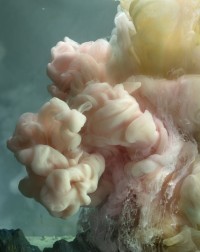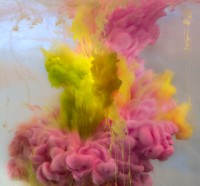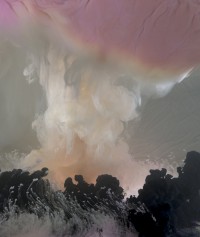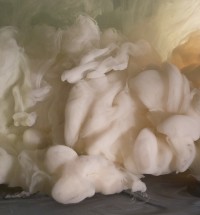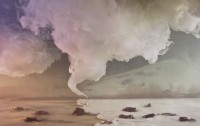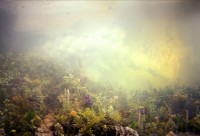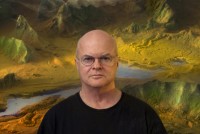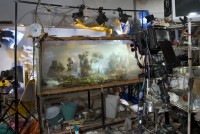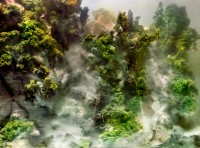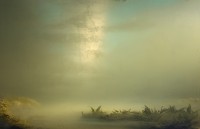Kim Keever
I can’t stop looking at Kim Keever’s “New Abstraction” series—the latest collection from the New York-based artist, whose photographs are known for their otherworldly landscapes.
Mr. Keever’s dreamy tableaus take inspiration from a broad painterly landscape tradition, especially that of Romanticism and the Hudson River School. But don’t be fooled by his influences—clearly Keever is creating something fresh. “It is my intention to present the landscape as beauty itself, without reference to man and industry,” Keever has said of his work. He carefully creates miniature panoramas inside or outside a tank, and fills it with water. Then, as he describes, “most of the action” takes place in the tank as paint is injected into the water for cloud formations.
For the “New Abstraction” series the artist drops pigments of paint into his tank and then, using his camera, promptly captures the mingling of pigments into these transient landscapes. Color appears to breathe—taking on shapes that reminds me of undulating underwater seascapes and billowing landscapes. The abstractions are profound—part real and part imagination.
Without further ado, here’s Rational Beauty’s Q&A with the talented Kim Keever.
Job description: I think of the acceptance of art in general as the shock of the unseen combined with what would seem to be the opposite of it—namely beauty. Perhaps there are more qualities one could mention but these are the ones that I hold dear. Someone who is really interested in “looking” has already seen so much of the typical that not much catches their eye. My goal is to combine the shock of the unseen with beauty.
Why do you do what you do? I certainly can’t say I’ve done it for the money. Though I’m beginning to do well in that respect, I continually think about and plan new ways of making my work. That’s really the thrill of it—the continuation of the work and where it leads me. I often think about new projects for several years before I start something.
How do you break through a creative block? I really can’t say I’ve had a creative block in a long time. And even then it didn’t last for more than a few hours. Once I knew that art was the best thing I could do for myself in the world, I just kept going.
Education: I graduated from Old Dominion University with a BS in thermal engineering. I went on to receive most of my Masters degree before dropping out and becoming an artist.
Mentors: Early on I chose Picasso as the most major. I admired his dedication and ability to make so much work with so many methods. It was this admiration that finally turned my head away from engineering and into the art world. In the contemporary world I would have to say Cindy Sherman and, to a lesser extent, Roxy Paine.
World-saving mission: I can’t say that art saves the world. It’s more about a kaleidoscopic vision that reflects on society and culture in a personal way even if the work is totally about society and culture. It’s for people who like to look.
Most useful tool: My most useful tool would be my Hasselblad digital camera. I could’ve bought a used Mercedes convertible and I suppose I would have done that too if I could have afforded it. Once I realized what a time-saving, and in the long run cheaper, way to make my work it was—as opposed to the 4 x 5 camera I had been using for a long time—I never thought about film again.
Guilty Pleasure: I love movies in general and it’s even more of a pleasure to be able to go in the afternoon when there are no real crowds. There is one drawback in that you tend to miss some of the jokes because there’s no crowd behind you laughing it up. There’s something about the big screen that I just don’t get with an at-home television. I’m always waiting for Friday to come around because the new movies come out.
What did you learn the hard way? That would be the old Roman parable about seizing the day. Most artists including myself seem like childish dreamers who never really grow up. Unfortunately, most artists don’t realize that having a lot of talent and making the work is only half of what it takes. The other half is putting yourself out there and finding a way to get people to understand and eventually buy your work. This is not easy, but necessary unless you are one of the lucky few doing the right thing at the right time and are discovered early on.
Has your work ever got you into trouble? I would imagine that most artists would say that it hasn’t. In my case I did get in trouble in high school. I really didn’t like the art teacher because he was very stiff and rigid. That’s the only real reason I can give for the work I turned in when asked to do an alleyway scene. In today’s world it probably wouldn’t be a big deal but years ago, even though it was the truth, you weren’t supposed to repeat all those dirty words you see in an alley in your artwork. So I was sent down to the principal’s office and a family member had to come to school or I would be kicked out. Luckily it didn’t escalate any further and I didn’t go out of my way to get in trouble again.
The other trouble for me has been walking out of the house with the water running in the tank and drenching the neighbors downstairs. I’ve done that three major times. The first couple times they were, I must say, very understanding. But the last time it happened I had to pay for a ceiling.
If you could cross over into other profession… what would you do? As I understand it, one of the reasons that Americans are more successful in the world is that they allow themselves to switch jobs and careers more freely than say Europeans. In my case I’ve never seriously thought about doing something else unless I had a few more lifetimes. This one seems too short and I still feel like there is so much art I would love to make with so many materials and methods.
Share: Twitter FacebookNext post
